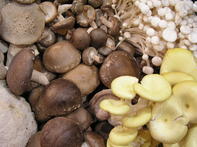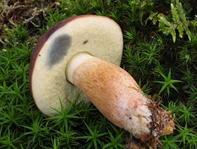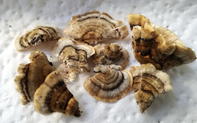There are hundreds of cultivated mushroom strains (of which there are more than 50 species) that are internationally available, but South African mushroom production only focuses on a few strains to supply a relatively conservative consumer base.

The most-produced variety is the shiitake mushroom, making up more than 20% of global production, mainly in China.In South Africa, the bulk (about 90%) of cultivated production consists of the white button, brown button mushroom (cremini) and brown mushrooms (portobella or portabello), all belonging to the genus Agaricus.
About 8 - 10% of the commercial mushroom retail market consists of exotic mushrooms, including oyster mushrooms (Pleurotus spp), shimeji and shiitake (Lentinula spp).
Botanically, portobella or portabello and crimini mushrooms (also called portabellini) are the same mushroom. The large brown mushrooms sold as portobellos are larger with dark open gills.
These are ripened crimini mushrooms. The gills of the button-shaped criminis/portabellinis are covered with a ‘mushroom skin’ or veil. It is an indication of maturity; no veil on the gills - older mushroom. Freshness, however, is determined by firmness. In Agaricus spesies, long stems and a spongy texture mean the mushroom is not fresh.
Exotic Mushrooms
Commercial production of exotic mushrooms in South Africa is still small (2019) but demand for shiitake and king oyster mushrooms are prompting increased production.
The superior flavour and health benefits of these ‘exotic’ or ‘gourmet’ mushrooms are prompting chefs to incorporate it more into their dishes and also offer it as meat alternatives to vegetarian and vegan diners.
A large exotic mushroom growing factory, Free E, opened in Sasolburg in Mpumalanga in 2017, specialising in the production of king oyster, shiitake as well as brown and white shimeji mushrooms. Production volumes are reputed to be 3 - 5 tonnes per day.
Wild Mushrooms

Mushroom-lovers also pick edible wild mushrooms which are often sold in informal farmer’s markets. A Capetonian fungi expert, Gary Goldmann, notes the popular edible mushroom types to include bay and poplar boletus, porcini and wood Blewitt.
Medicinal Mushrooms

The topic of medicinal mushrooms is a vast one and may also include the use of non-edible mushrooms for spiritual and cultural rituals. Below is a brief mention of a few edible mushrooms and their benefits in terms of diseases.
Mushrooms have been used for centuries in folk medicine and with increased travel have exposed Western travellers to the taste and benefits of traditional Eastern mushroom types.
One such example is Hericium erinaceus, also known as yamabushitake or satyr’s beard. Lion’s mane is a well-known food and medicinal mushroom that is being studied and promoted for the nerve growth factor it contains - erinacine - as well as erinacine A. Both these agents may slow down degenerative neurological diseases such as Parkinson’s disease and Alzheimer’s disease and protect the body against strokes and depression.
Other health benefits attributed to edible mushrooms include protection against and treatment of breast cancer by boosting the immune response (turkey tail mushroom). Oyster mushrooms can lower blood cholesterol levels and reishi mushrooms help the control of blood glucose levels and modulation of the immune system. The shiitake mushroom is excellent as an anti-inflammatory food. Also, the lentinan content in shiitakes helps heal chromosome damage caused by cancer treatments.
Please Note:
Information is for educational and informational purposes only and may not be construed as medical or nutritional advice. The information is not intended to replace medical advice or treatment offered by healthcare professionals.
By Marinda Louw